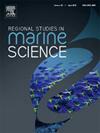Assessing the stock status of pointhead flounder (Cleisthenes pinetorum) and blackfin flounder (Glyptocephalus stelleri) in the East Sea of Korea using length-based methods
IF 2.1
4区 环境科学与生态学
Q3 ECOLOGY
引用次数: 0
Abstract
Pointhead flounder (Cleisthenes pinetorum) and blackfin flounder (Glyptocephalus stelleri) are key commercial species distributed in the East Sea off the Korean coast. Evaluating the stock status of commercial fish is essential for sustainable fisheries management, as it informs conservation efforts and resource allocation. This study evaluated the stock status of these two flounder species using three length-based assessment methods: TropFishR, length-based spawning potential ratio (LBSPR), and length-based Bayesian Biomass (LBB). Length and weight data from 1947 pointhead flounders and 4715 blackfin flounders were collected in the eastern waters of Korea. Both species exhibited positive allometric growth patterns, with b values of 3.40 and 3.39, respectively. Among the growth parameters estimated via the ELEFAN-GA method, the asymptotic length was 43.44 and 42.27 cm, and the growth coefficient was 0.20 and 0.16 year⁻¹ for pointhead and blackfin flounder, respectively, while the total mortality derived from the length-converted catch curve for the two species was 1.19 year⁻¹ and 0.92 year⁻¹ , respectively. Both species showed exploitation rates above the optimal value of 0.5 (0.69 for pointhead flounder and 0.66 for blackfin flounder), which indicated overexploitation. The LBSPR results revealed low spawning potential ratios of 0.19 for the former and 0.23 for the latter, which indicated recruitment overfishing. Furthermore, growth overfishing was also evident, as most samples were below the length at first maturity, i.e., 24.67 cm for pointhead flounder and 24.09 cm for blackfin flounder. The ratio of fishing mortality to natural mortality was 2.87 and 2.25, respectively, exceeding the reference point of 1 for both species, while that of current biomass to virgin biomass was 0.12 and 0.15, respectively, both below the reference point of 0.50. The current fishing mortality rates were 61.44 % and 36.06 % higher than the reference point F₀.₄ for pointhead flounder and blackfin flounder, respectively.
求助全文
约1分钟内获得全文
求助全文
来源期刊

Regional Studies in Marine Science
Agricultural and Biological Sciences-Ecology, Evolution, Behavior and Systematics
CiteScore
3.90
自引率
4.80%
发文量
336
审稿时长
69 days
期刊介绍:
REGIONAL STUDIES IN MARINE SCIENCE will publish scientifically sound papers on regional aspects of maritime and marine resources in estuaries, coastal zones, continental shelf, the seas and oceans.
 求助内容:
求助内容: 应助结果提醒方式:
应助结果提醒方式:


